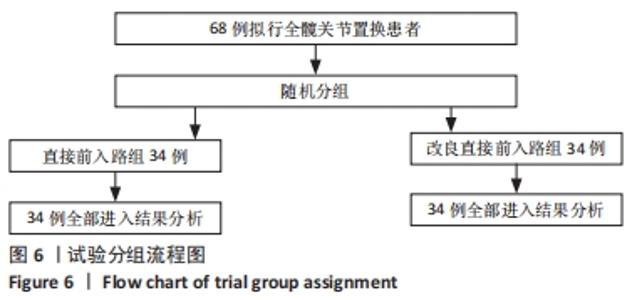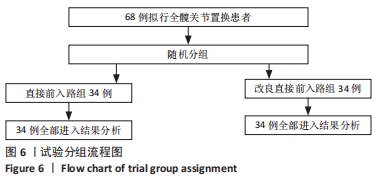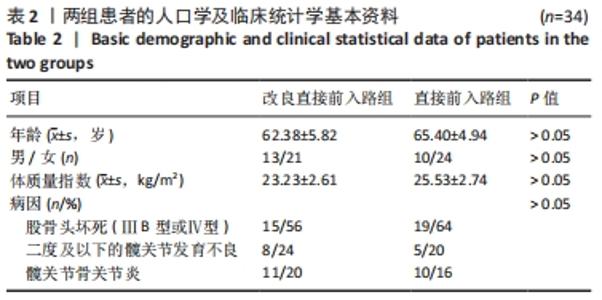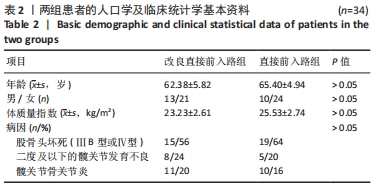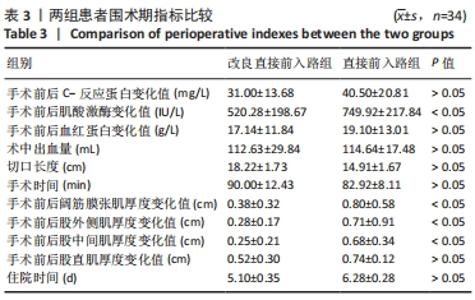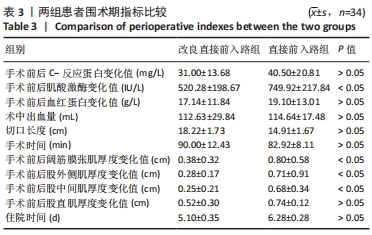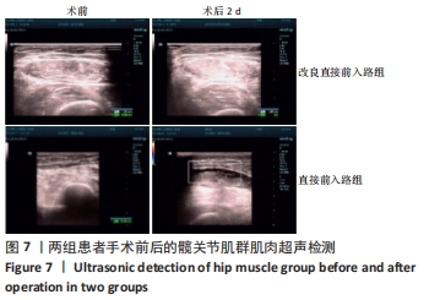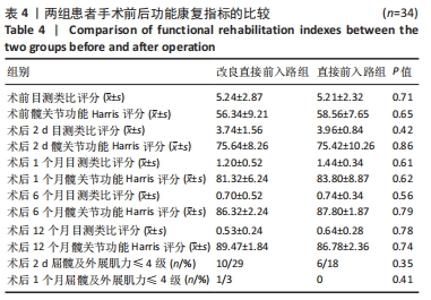Chinese Journal of Tissue Engineering Research ›› 2023, Vol. 27 ›› Issue (9): 1377-1382.doi: 10.12307/2023.213
Previous Articles Next Articles
Comparison of 12-month follow-up results of primary total hip arthroplasty between modified direct anterior approach and direct anterior approach
Ke Yuqi, Chen Changjian, Wu Hao, Zheng Lianjie
- Second Affiliated Hospital of Dalian Medical University, Dalian 116023, Liaoning Province, China
-
Received:2021-12-01Accepted:2022-02-09Online:2023-03-28Published:2022-07-01 -
Contact:Chen Changjian, Attending physician, Second Affiliated Hospital of Dalian Medical University, Dalian 116023, Liaoning Province, China -
About author:Ke Yuqi, Master candidate, Second Affiliated Hospital of Dalian Medical University, Dalian 116023, Liaoning Province, China
CLC Number:
Cite this article
Ke Yuqi, Chen Changjian, Wu Hao, Zheng Lianjie. Comparison of 12-month follow-up results of primary total hip arthroplasty between modified direct anterior approach and direct anterior approach[J]. Chinese Journal of Tissue Engineering Research, 2023, 27(9): 1377-1382.
share this article
Add to citation manager EndNote|Reference Manager|ProCite|BibTeX|RefWorks
| [1] 王野舟,肖荣驰.人工全髋关节置换术前设计的研究进展[J].世界最新医学信息文摘,2018,18(6):61-63. [2] Learmonth ID, Young C, Rorabeck C. The operation of the century: total hip replacement. Lancet. 2007 Oct 27;370(9597):1508-19. doi: 10.1016/S0140-6736(07)60457-7. [3] 韩广弢,李皓桓.全髋关节置换术不同手术入路的研究进展[J].疑难病杂志,2019,18(5):537-540. [4] PETIS S, HOWARD JL, LANTING BL, et al . Surgical approach in primary total hip arthroplasty: anatomy, technique and clinical outcomes. Can J Surg. 2015;58(2):128-139. [5] BERRY DJ, BERGER RA, CALLAGHAN JJ, et al. Minimally invasive total hip arthroplasty. Development, early results, and a critical analysis. Presented at the Annual Meeting of the American Orthopaedic Association, Charleston, South Carolina, USA, June 14, 2003. J Bone Joint Surg Am. 2003;85(11):2235-2246. [6] MEERMANS G, KONAN S, DAS R, et al. The direct anterior approach in total hip arthroplasty: a systematic review of the literature. Bone Joint J. 2017;99-B(6):732-740. [7] FRYE BM, BEREND KR, LOMBARDI AV JR, et al. Do sex and BMI predict or does stem design prevent muscle damage in anterior supine minimally invasive THA? Clin Orthop Relat Res. 2015;473(2):632-638. [8] SIOEN W, MEERMANS G, LENAERT A. Surgical technique description : Transosseous ‘over the top’ reconstruction of capsule and tendons in primary total hip arthroplasty using a posterior approach. Acta Orthop Belg. 2017;83(1):87-92. [9] CHRISTENSEN CP, KARTHIKEYAN T, JACOBS CA. Greater prevalence of wound complications requiring reoperation with direct anterior approach total hip arthroplasty. J Arthroplasty. 2014;29(9):1839-1841. [10] MAEZAWA K, NOZAWA M, YUASA T, et al. Early clinical results of total hip arthroplasty assessed with the 25-question Geriatric Locomotive Function Scale and muscle strength testing. J Orthop Sci. 2018;23(3):538-541. [11] CHENG TE, WALLIS JA, TAYLOR NF, et al . A Prospective Randomized Clinical Trial in Total Hip Arthroplasty-Comparing Early Results Between the Direct Anterior Approach and the Posterior Approach. J Arthroplasty. 2017;32(3):883-890. [12] HEALEY JH, KAGEN LJ, VELIS KP, et al. Creatine kinase MB in skeletal muscle and serum of spine-fusion patients. Clin Orthop Relat Res. 1985;(195):282-288. [13] LAURENCE AS. Serum myoglobin and creatine kinase following surgery. Br J Anaesth. 2000;84(6):763-766. [14] COHEN RG, KATZ JA, SKREPNIK NV. The relationship between skeletal muscle serum markers and primary THA: a pilot study. Clin Orthop Relat Res. 2009;467(7):1747-1752. [15] MAMMEN AL. Statin-Associated Myalgias and Muscle Injury-Recognizing and Managing Both While Still Lowering the Low-Density Lipoprotein. Med Clin North Am. 2021;105(2):263-272. [16] MATĚJKA T, ZEMAN J, BELATKA J, et al. Creatine Kinase and Myoglobin Levels as Indicators of Perioperative Muscle Damage during Open- and Mini-Invasive Stabilization of Thoracic and Lumbar Spine Fracture - a Prospective Randomized Study. Acta Chir Orthop Traumatol Cech. 2020;87(1):9-16. [17] ROCHKIND S, SHAINBERG A. Muscle Response to Complete Peripheral Nerve Injury: Changes of Acetylcholine Receptor and Creatine Kinase Activity over Time. J Reconstr Microsurg. 2017;33(5):352-357. [18] DAWES DM, HO JD, SWEENEY JD, et al. The effect of an electronic control device on muscle injury as determined by creatine kinase enzyme. Forensic Sci Med Pathol. 2011;7(1):3-8. [19] SCHOMAKER S, POTTER D, WARNER R, et al. Serum glutamate dehydrogenase activity enables early detection of liver injury in subjects with underlying muscle impairments. PLoS One. 2020;15(5):e0229753. [20] MJAALAND KE, KIVLE K, SVENNINGSEN S, et al. Comparison of markers for muscle damage, inflammation, and pain using minimally invasive direct anterior versus direct lateral approach in total hip arthroplasty: A prospective, randomized, controlled trial. J Orthop Res. 2015;33(9):1305-1310. [21] RYKOV K, REININGA IHF, SIETSMA MS, Et al. Posterolateral vs Direct Anterior Approach in Total Hip Arthroplasty (POLADA Trial): A Randomized Controlled Trial to Assess Differences in Serum Markers. J Arthroplasty. 2017;32(12):3652-3658.e1. [22] TAMAKI T, OINUMA K, MIURA Y, et al. Epidemiology of Dislocation Following Direct Anterior Total Hip Arthroplasty: A Minimum 5-Year Follow-Up Study. J Arthroplasty. 2016;31(12):2886-2888. [23] KUNKEL ST, SABATINO MJ, KANG R, e al. A systematic review and meta-analysis of the direct anterior approach for hemiarthroplasty for femoral neck fracture. Eur J Orthop Surg Traumatol. 2018;28(2):217-232. [24] WANG YL, CHANG Y, LI SL, et al. [Methods and effects of high-frequency color Doppler ultrasound assisted reverse island flap of dorsal digital artery of ulnar thumb for repairing skin and soft tissue defects in the distal end of the same finger]. Zhonghua Shao Shang Za Zhi. 2021; 37(6):555-561. [25] BERGIN PF, DOPPELT JD, KEPHART CJ, et al. Comparison of minimally invasive direct anterior versus posterior total hip arthroplasty based on inflammation and muscle damage markers. J Bone Joint Surg Am. 2011;93(15):1392-1398. [26] NEUMAIER M, METAK G, SCHERER MA. C-reactive protein as a parameter of surgical trauma: CRP response after different types of surgery in 349 hip fractures. Acta Orthop. 2006;77(5):788-790. [27] 查小伟,程文丹,吕浩,等.全髋关节置换直接前入路与后外侧入路患者的早期疗效比较[J].中国组织工程研究,2018,22(35):5583-5589. [28] MAST NH, LAUDE F. Revision total hip arthroplasty performed through the Hueter interval. J Bone Joint Surg Am. 2011;93 Suppl 2:143-148. [29] KENNON R, KEGGI J, ZATORSKI LE, et al. Anterior approach for total hip arthroplasty: beyond the minimally invasive technique. J Bone Joint Surg Am. 2004;86-A Suppl 2:91-97. [30] KAWARAI Y, IIDA S, NAKAMURA J, et al. Does the surgical approach influence the implant alignment in total hip arthroplasty? Comparative study between the direct anterior and the anterolateral approaches in the supine position. Int Orthop. 2017;41(12):2487-2493. [31] MICHALOWITZ A, COMRIE R, NICHOLAS C, et al. Wound Complications after 2-Octyl Skin Closure Systems for Total Joint Arthroplasty. J Bone Jt Infect. 2020;5(2):101-105. |
| [1] | You Aijia, Li Wenjie, Zhou Junli, Li Chun. Systematic evaluation of six dressings on wound safety following total hip and knee arthroplasty [J]. Chinese Journal of Tissue Engineering Research, 2023, 27(3): 486-492. |
| [2] | Zhuang Zhikun, Wu Rongkai, Lin Hanghui, Gong Zhibing, Zhang Qianjin, Wei Qiushi, Zhang Qingwen, Wu Zhaoke. Application of stable and enhanced lined hip joint system in total hip arthroplasty in elderly patients with femoral neck fractures complicated with hemiplegia [J]. Chinese Journal of Tissue Engineering Research, 2022, 26(9): 1429-1433. |
| [3] | Huang Shibo, Xie Hui, Wang Zongpu, Wang Weidan, Qin Kairong, Zhao Dewei. Application of degradable high-purity magnesium screw in the treatment of developmental dysplasia of the hip [J]. Chinese Journal of Tissue Engineering Research, 2022, 26(4): 493-498. |
| [4] | Yuan Bo, Li Kainan, Jia Zishan. Comparison of the effects of different modes of balance disorder rehabilitation robots after total hip arthroplasty in the elderly [J]. Chinese Journal of Tissue Engineering Research, 2022, 26(36): 5826-5830. |
| [5] | Ma Ning, Wang Cong, Liu Ningqiang, Xie Tong, Yang Chaojian, Guo Chongjun, Niu Dongsheng, Liang Yuqi. Stability of 3D-printed titanium trabecular metal socket cups during total hip arthroplasty [J]. Chinese Journal of Tissue Engineering Research, 2022, 26(33): 5278-5282. |
| [6] | Li Kai, Liu Zhendong, Li Xiaolei, Wang Jingcheng. Risk factors for recurrent prosthesis dislocation after total hip arthroplasty through posterolateral approach [J]. Chinese Journal of Tissue Engineering Research, 2022, 26(3): 354-358. |
| [7] | Wang Chong, Zhang Meiying, Zhou Jian, Lao Kecheng. Early gait changes after total hip arthroplasty through direct anterior approach and posterolateral approach [J]. Chinese Journal of Tissue Engineering Research, 2022, 26(3): 359-364. |
| [8] | Chen Yong, Sun Yang. Effect of zoledronic acid on femoral implant subsidence after hip arthroplasty [J]. Chinese Journal of Tissue Engineering Research, 2022, 26(12): 1812-1815. |
| [9] | Zhang Chong, Liu Zhiang, Yao Shuaihui, Gao Junsheng, Jiang Yan, Zhang Lu. Safety and effectiveness of topical application of tranexamic acid to reduce drainage of elderly femoral neck fractures after total hip arthroplasty [J]. Chinese Journal of Tissue Engineering Research, 2021, 25(9): 1381-1386. |
| [10] | Zhang Weicheng, Li Rongqun, Wu Mingzhou, Zheng Kai, sun houyi, Zhang Lianfang, Zhou Jun, Xu Yaozeng. Comparison of one-stage bilateral total hip arthroplasty between SuperPATH approach and posterolateral approach based on enhanced recovery after surgery [J]. Chinese Journal of Tissue Engineering Research, 2021, 25(33): 5312-5317. |
| [11] | Huo Jiabang, Zhao Chang, Huang Guangxin, Wang Xinjie, Bu Yufan, Zhu Jinjian, Cai Daozhang . Accuracy and reproducibility of three-dimensional planning based on CT data for predicting prosthesis type and osteotomy in total hip arthroplasty [J]. Chinese Journal of Tissue Engineering Research, 2021, 25(27): 4294-4299. |
| [12] | Li Long, Wang Hailong, Kang Peng, Chen Shengguo, Yilihamu•Tuoheti. Transverse acetabular ligament as a marker for acetabular prosthesis anteversion in total hip arthroplasty [J]. Chinese Journal of Tissue Engineering Research, 2021, 25(27): 4322-4326. |
| [13] | Zhang Yang, Wang Dasai, Wang Qiang. Risk factors for impingement between the femoral stem tip and the distal femoral cortex after first total hip arthroplasty [J]. Chinese Journal of Tissue Engineering Research, 2021, 25(27): 4339-4343. |
| [14] | Ren Sijun, Cao Zhipeng, Xu Rao, Ru Jiangying. Fixation of the modified Pauwels type Ⅲ femoral neck fractures in young adults with percutaneous hollow compression screw combined with medial buttress plate: 2-year follow-up [J]. Chinese Journal of Tissue Engineering Research, 2021, 25(27): 4354-4360. |
| [15] | Wang Debin, Bi Zhenggang. Internal fixation and arthroplasty for femoral neck fracture in the elderly: how to reflect individualized precision treatment [J]. Chinese Journal of Tissue Engineering Research, 2021, 25(27): 4395-4400. |
| Viewed | ||||||
|
Full text |
|
|||||
|
Abstract |
|
|||||
